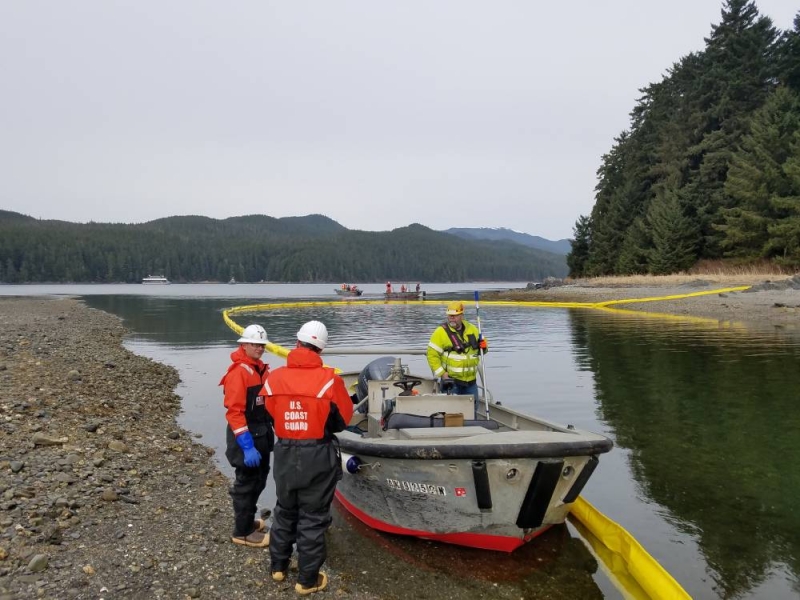
Spill response exercises and frequent training opportunities are integral to the overall preparedness efforts for OR&R, NOAA, and our partners in both industry and the government. Some exercises are even required by law to ensure all parties are prepared for an oil spill. All vessels over 400 gross tons — which includes almost all ocean-going vessels and large fishing vessels — are required to have a vessel response plan. Per the Oil Pollution Act of 1990, vessels are also required to meet federal oil pollution response exercise requirements.
One of the ways to satisfy this requirement is to participate in an exercise through the U.S. Coast Guard’s Preparedness for Response Exercise Program — or PREP, for short. PREP provides full-scale exercises that incorporate all the various components of active oil spill response in marine environments — from a simulated incident and responsible party, to the collaborative efforts between official government responders and industry experts.
Earlier this month, the U.S. Coast Guard hosted the 2019 Southeast Alaska Area PREP Exercise in Juneau, Alaska. The exercise was a culmination of two years of planning, with participants from other parts of Alaska, the lower-48 states, Canada, and Germany. The three-day event included a training day, a field deployment day, and a table top exercise.
The exercise scenario was set in Hawk Inlet on Alaska’s Admiralty Island at a marine-side dock belonging to Hecla-Greens Creek Mine. The mine, along with Olendorff Carriers and Gallagher Marine Systems, served as the responsible party, or industry participants. Olendorff, headquartered in Germany, is the only shipping carrier that services Hecla-Green Creek Mine. The planned scenario was an oil spill from an Olendorff bulk ore carrier, with a fuel tank breach resulting in the release of 108,000 gallons of intermediate fuel oil (Bunker-C).
There were representatives from the U.S. Coast Guard, Alaska Departments of Environmental Conservation (ADEC) and Natural Resources, U.S. Fish and Wildlife Service, National Marine Fisheries Service, U.S. Forest Service, Southeast Alaska Petroleum Response Organization (SEAPRO), and NOAA’s scientific support coordinator—the usual participants from the Alaska response community. Canadian Coast Guard also participated as part of a cross-boundary planning experience.
The training day was an opportunity for the exercise controllers, evaluators, coaches and players to gather and meet each other and to understand their various assignments. Presentations were given to familiarize everyone with Olendorff Carriers and the Hecla-Greens Creek Mine (HGCM) and their operations in Alaska.
The field deployment day began at 4:30 a.m., as the exercise field team boarded the Hecla-Greens Creek Mine’s crew boat for a 45-minute ride from Juneau’s Auke Bay to Young Bay on Admiralty Island. From Young Bay dock, participants debarked the boat and boarded a bus for another 15 minute ride to the mine headquarters based at the renovated historic Hawk Inlet Cannery facility. Here, all participants received a “Miner-for-the-day” safety briefing, and the day’s spill response operations brief.
An oil spill response field deployment exercise allows responders to practice their skills in deploying the response equipment on the water and tests the adequacy of the responder’s spill response plan. In this exercise, the responders deployed boom to protect pre-identified sensitive shoreline sites and also tested their ability to corral and collect spilled oil (no oil was spilled for this exercise) using different boom-towing configurations and on-site skimming gear. This was an incredibly cooperative endeavor as participants all came together, working as a team, to perform the on-water tasks.
While the on-water operations were occurring, other members of the field team set up and tested the operation of a forward incident command post at the mine site. The forward post would serve as the on-site management for the operations as well as the “eyes” and communications center for the larger incident command post managing the response back in Juneau. At the end of the field day, the team traveled back to Juneau via bus and crew boat, arriving at the Auke Bay dock at 6:30 p.m.
The final day of the PREP exercise was the table top exercise, or a practice enactment of an incident management team. The team, made up of the participants listed above, comes together at an incident command post and works together to respond to the scenario by developing an Incident Action Plan. During the exercise, players from the federal and state agencies and industry partners work together to meet the scenario objectives: human safety, secure and remove the pollution, and protect the environment. A unified command, which includes a federal on scene coordinator from the U.S. Coast Guard, a state on scene coordinator, and an incident commander from the responsible party (in this case Olendorff), directs the development of plans and operations to respond to the incident. With safety at the forefront, plans are devised; natural resources, cultural resources, and environmental sensitivities are considered; tactics and strategies are designed; and assignments are made to respond as quickly and efficiently as possible to the spill incident.
In a full-scale exercise such as this one, other roles are established to help run the play and ensure that the objectives can be accomplished successfully. Controllers provide realistic information to keep the play directed and appropriately focused. Coaches are provided to assist players in understanding their responsibilities. And evaluators are present throughout to evaluate the exercise process and provide feedback to improve performance.
Oil spill response exercises provide a great opportunity for government agencies, response organizations, and industry to work together in a non-threatening and supportive environment. It is a great time to learn and understand each others’ concerns and limitations and develop important relationships before a real event happens — and it will, happen.
